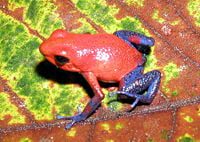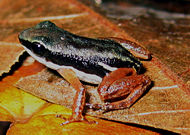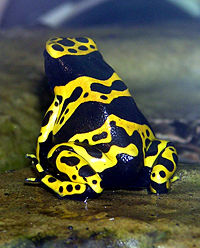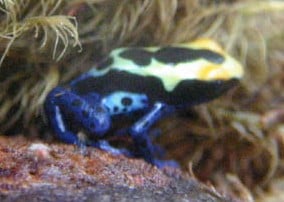Poison dart frog
| Poison dart frogs | ||||||||||
|---|---|---|---|---|---|---|---|---|---|---|
 Red and Blue "Blue Jeans" Dendrobates pumilio Strawberry Poison Dart Frog
| ||||||||||
| Scientific classification | ||||||||||
| ||||||||||
 Distribution of Dendrobatidae (in black)
| ||||||||||
|
Proposed Subfamily Colostethinae
Proposed Subfamily Hyloxalinae
Proposed Subfamily Dendrobatinae
Proposed obsolete (invalid) Dendrobatidae genera:
|
Poison dart frog (also poison arrow frog, dart frog or poison frog) is the combined common name of four main families of small, diurnal frogs: Dendrobates, Epipedobates, Minyobates and Phyllobates. Poison dart frogs are native to several continents, but primarily to Central and South America. The frogs are widely called poison arrow frogs or poison dart frogs, a generalization reflecting the widespread notion that all poison frogs are used by South American tribes in the manufacture of poison that is spread on arrows or blow-gun darts. In actuality, of over one hundred seventy-five species of poison frog, only three are toxic enough to use for this purpose, and none come from the Dendrobatidae family, that which is most characterized by the brilliant color and complex patterns of its member species.
Toxocology
Scientists have discovered that poison frogs cannot actually manufacture any of the toxic alkaloids they defend themselves with. Though they did not evolve the ability to produce the toxins, they did evolve a relationship with alkaloid-rich ants and other insects from which they steal potent alkaloids such as pumiliotoxins, one of many varieties of batrachotoxins. In captivity, the frogs are fed cultured insects that do not represent their diet in the wild. Since easily purchasable foods such as fruit flies and extra-small crickets are not rich in the required alkaloids, poison frogs do not produce toxins and they lose their toxicity in captivity. In fact, many hobbyists and herpetologists have reported that most dart frogs will not consume ants at all in captivity, though ants comprise the larger portion of their diet in the wild. Though all poison frogs lose their toxicity when deprived of certain foods, and captive bred poison frogs (except for one Australian species) are born harmless, a wild-caught poison frog can retain alkaloids for years. Scientists have recently found that some poison frogs not only absorb the alkaloids of ants, but even have the ability to modify them, creating more toxic variants. For example, while Dendrobates auratus consumes pumiliotoxin 251D and merely stores it, some members of the Dendrobatidae family convert pumiliotoxin 251D to allopumiliotoxin 267A, which is five times more toxic than the original version. The most toxic poison frog of all is the Golden Poison Dart Frog (Phyllobates terribilis). It is estimated that one frog harbors enough toxin at any given time to kill between 8 and 20 adult humans. Because they are vile-tasting and usually deadly when ingested, poison frogs have no natural predators, and this is one factor that adds to their popularity as pets: Since they have no natural predators, the frogs are not bothered at all by the close presence of large animals, including humans.
Poison frogs are creatures of great scientific interest to evolutionary biologists. The frog's intriguing ability to resist, store, and manipulate toxins, along with its related role in the food chain, are among the most important discoveries in the study of food-chain evolution. Biologists have speculated that the frogs must have first evolved a resistance to the alkaloids in response to using the ants as a food source. The ability to digest even toxic foods allowed them capitalize on an otherwise-untouched food source, a fairly common event on the evolutionary scale. Once having developed a resistance to such foods over the course of countless generations, any genetic variation that happened to make the ingested poison accumulate closer to the skin's surface would have bestowed a greater advantage with each beneficial mutation. Secreting this new weapon, they would have then evolved their bright colors and adapted to a diurnal schedule in response to the absence of natural predators, and some frogs would go as far as to evolve the ability to manipulate the toxins they consumed, thus increasing their deterrence to predators and their likelihood to survive.
Background

Many poison dart frogs have brightly colored skin and can be very small, ranging in size from 1 to 6 centimeters in length, depending on the age, sex, and the species of the frog. In size, many species average no larger than a human thumbnail. They come in a variety of colors, but not all species are bright colored. Other animals recognize these brighter colors as a danger sign. Some frogs can have up to 200 micrograms of poison, enough to kill 100 adult humans.
Reproduction and Parental Care
In most species, eggs are laid near the forest floor by the female, usually in a sheltered and moist spot. Most species of poison frog reproduce through oviparity, that is, the female lays infertile eggs and the male fertilizes them externally, in the same manner as most fish. Many hobbyists mistakenly conclude that poison frogs are mating, when they are actually engaged in a wrestling match over territory. Once the eggs are laid and fertilized, one parent (generally the male) guards them until they hatch. The newly hatched tadpoles wriggle onto the back of either the male or female parent, who transports them to water, often a small pool or the water trapped in the axil of a Bromeliad plant. Because female poison frogs are both extremely territorial and competitive, a parent must constantly guard its eggs in order to prevent a rival female from devouring them, thus removing future competition from the gene pool.
In some species, the female returns to the tadpoles repeatedly to lay infertile eggs for them to feed upon. In a few species this is the only source of food for the tadpoles until they undergo metamorphosis into sub-adult froglets; these species are called 'obligate egg feeders'. Obligate egg-feeding species can be especially difficult to rear in captivity, but many breeders have had success with other food substitutes such as small fish eggs.
Poison frogs in captivity
In captivity, poison dart frogs have a lifespan of 5 to 12+ years, but little data exists for wild frogs. Poison dart frogs are commonly bred in captivity to be non-toxic. Most species reach maturity around 1.5 to 2.5 years of age.
The easiest way to determine the sex of a particular species of poison dart frog is by observation in the wild. Mature male frogs will usually make a mating call after eating or after a heavy misting of water. The sound is similar to that of a series of high-pitched "clicks." In juvenile frogs the sex can sometimes be determined by the profile of the amphibian. The backs of males usually slope down with less of a break than females. Females are usually rounder and show a bigger break.
Another simpler way to sex these frogs is by their toes. A female dendrobates will have narrow toes all the way down and a male's toes get very wide at the ends. Mature males also show a small section of grey skin on their neck. This is where the mating call is produced.
In captivity, most species thrive where the humidity is kept constant at 80-100% and where the temperature is around 75-80 F degrees (24-27 °C) during the day and no lower than 60-65 F degrees (16-18 °C) at night.
Color morphs
Some species include a number of sub-species 'morphs'. Different morphs represent geographically separated populations of the same species in the wild, showing different coloration. For example, the species Dendrobates tinctorius includes at least a dozen morphs.
ReferencesISBN links support NWE through referral fees
- Amphibian Species of the World - Dendrobates, Cope, 1865. Retrieved September 29, 2007.
- Grant, Taran; Frost, Darrel R.; Caldwell, Janalee P.; Gagliardo, Ron; Haddad, Celio F.B.; Kok, Philippe J.R.; Means, D. Bruce; Noonan, Brice P.; Schargel, Walter E. & Wheeler, Ward (2006): Phylogenetic systematics of dart-poison frogs and their relatives (Amphibia, Athesphatanura, Dendrobatidae). Bulletin of the American Museum of Natural History 299: 1-262. PDF fulltext Retrieved September 29, 2007.
| Chordata - Amphibia - Families of Anura | |
|---|---|
|
Allophrynidae - Amphignathodontidae - Arthroleptidae - Ascaphidae - Bombinatoridae - Brachycephalidae - Bufonidae - Centrolenidae - Dendrobatidae - Discoglossidae - Heleophrynidae - Hemisotidae - Hylidae - Hyperoliidae - Leiopelmatidae - Leptodactylidae - Mantellidae - Megophryidae - Microhylidae - Myobatrachidae - Nasikabatrachidae - Pelobatidae - Pelodytidae - Pipidae - Ranidae - Rhacophoridae - Rhinodermatidae - Rhinophrynidae - Scaphiopodidae - Sooglossidae | |
Credits
New World Encyclopedia writers and editors rewrote and completed the Wikipedia article in accordance with New World Encyclopedia standards. This article abides by terms of the Creative Commons CC-by-sa 3.0 License (CC-by-sa), which may be used and disseminated with proper attribution. Credit is due under the terms of this license that can reference both the New World Encyclopedia contributors and the selfless volunteer contributors of the Wikimedia Foundation. To cite this article click here for a list of acceptable citing formats.The history of earlier contributions by wikipedians is accessible to researchers here:
The history of this article since it was imported to New World Encyclopedia:
Note: Some restrictions may apply to use of individual images which are separately licensed.

